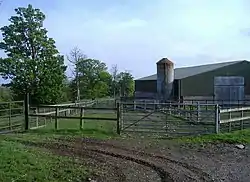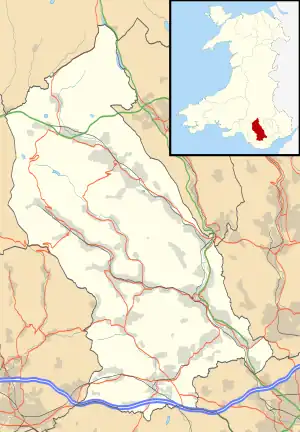| Castellau | |
|---|---|
 | |
 Castellau Location within Rhondda Cynon Taf | |
| Principal area | |
| Preserved county | |
| Country | Wales |
| Sovereign state | United Kingdom |
| Post town | PONTYCLUN |
| Postcode district | CF72 |
| Dialling code | 01443 |
| Police | South Wales |
| Fire | South Wales |
| Ambulance | Welsh |
| UK Parliament | |
| Senedd Cymru – Welsh Parliament | |
Castellau ("fortifications"; alternate: Castella)[1] is a hamlet,[2] with a country house of the same name in the county borough of Rhondda Cynon Taf, South Wales. Historically, it lies within the parish of Llantrisant, just north-west of Beddau.[2] It is connected with the history of the Trahernes. In 1988, Ysgol Castellau became the first Welsh medium education school to open in the southeast within new buildings.[3]
Geography
After crossing the Rhondda, the road rises out of the valley in a southerly direction nearly due south to Castellau. Castellau is located less than a mile north-west of Beddau.[4] A forge was situated in a small valley, Darren Ddeusant,[5] extending upwards by the mansion, Castellau House, into the hills to the north of Llantrisant.[6] This hamlet contains some coal works, part of the produce of which is shipped for Ireland.[2]
History

While the name imports a fortified place, nothing is known of its history. It might have formed an outpost to the castle of Llantrisant.[1] The Traherne family lived for several centuries at Castellau. They are descended through Sir George Herbert of Swansea, son of Sir Richard Herbert.[7] It was later owned by a Mrs. Smith.[8]
Castellau
Built in the late Classical Regency style, Castellau probably predates 1807. The large two-storeyed house[9] is a remodel from a 17th-century three-unit house. The interior has a semicircular staircase, square hall, bow-ended dining room, Ionic columns, marble chimneypiece, cast iron balustrade. The white house's exterior features bowed ends, a six-bay facade, central doorway, slate roof, cantilevered eaves, and a cast iron veranda.[10]
Chapel
Chapel Castellau Independent was built in 1842 or 1843 and a renovation occurred in 1877. It was not used only as a place of worship. In 1851, Joshua Evans of Cymmar was its minister while in 1865, Henry Oliver served as minister.[11] The chapel is located 1 mile (1.6 km) south of the house; featuring angled pinnacles and transomed lancets, the interior has galleries on three sides and a polygonal pulpit.[10]
References
- 1 2 Brayley, Edward Wedlake; Britton, John (1815). The Beauties of England and Wales, Or, Delineations, Topographical, Historical, and Descriptive, of Each County: South Wales (Now in the public domain. ed.). Printed by T. Maiden, for Vernor and Hood. pp. 651–52.
- 1 2 3 Lewis, Samuel (1833). A topographical dictionary of Wales: comprising the several counties, cities, boroughs, corporate and market towns, parishes, chapelaries, and townships, with historical and statistical descriptions: embellished with engravings of the arms of the cities, bishoprics, corporate towns, and boroughs; and of the seals of the various municipal corporations. With an appendix describing the electoral boundaries of the several boroughs, as defined by the late act: also illustrated by maps of the different counties, and a map of north and south Wales (Now in the public domain. ed.). S. Lewis. p. 218.
- ↑ Williams, Iolo Wyn (2003). Our Children's Language: The Welsh-Medium Schools of Wales, 1939-2000. Y Lolfa. p. 66. ISBN 978-0-86243-704-6.
- ↑ Lewis, Dillwyn (1966). The history of Llantrisant. Beddau Centenary Committee. p. 105.
- ↑ Williams, Stewart; Denning, R. T. W. (1967). Stewart Williams' Glamorgan historian. Cowbridge: D. Brown. p. 48.
- ↑ Cambrian Archaeological Association (1863). Archaeologia cambrensis (Now in the public domain. ed.). W. Pickering. pp. 92–. Retrieved 21 August 2011.
- ↑ Joseph Jackson Howard, ed. (1884). Miscellanea genealogica et beraldica. Vol. IV (Now in the public domain. ed.). London: Hamilton, Adams, and Co. p. 102.
- ↑ A handbook for travellers in South Wales (Now in the public domain. ed.). John Murray. 1860. pp. 14–. Retrieved 21 August 2011.
- ↑ Royal Commission on Ancient and Historical Monuments in Wales (September 1981). An Inventory of the Ancient Monuments in Glamorgan: Domestic architecture from the Reformation to the Industrial Revolution. pt. 1. The greater houses. H.M.S.O. ISBN 978-0-11-700754-3. Retrieved 24 August 2011.
- 1 2 Newman, John (1995). Glamorgan: (Mid Glamorgan, South Glamorgan and West Glamorgan). Yale University Press. pp. 64, 402, 403–. ISBN 978-0-14-071056-4.
- ↑ Hicks, Gareth (2 March 2011). "Castellau Welsh Independent Chapel, Llantrisant". genuki.org.uk. Retrieved 21 August 2011.
